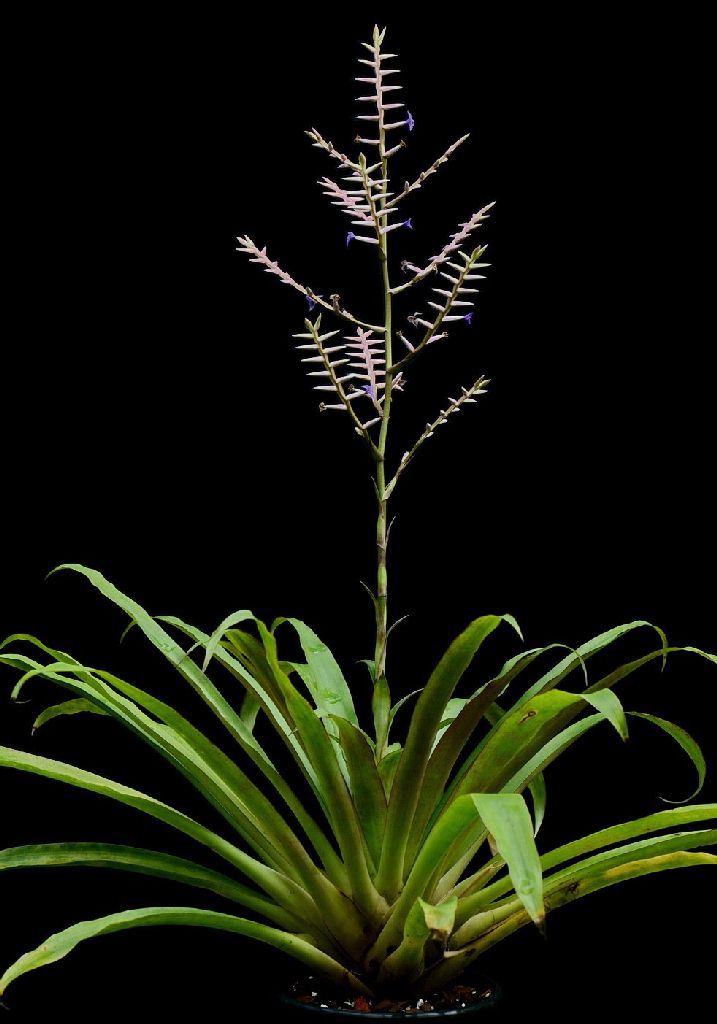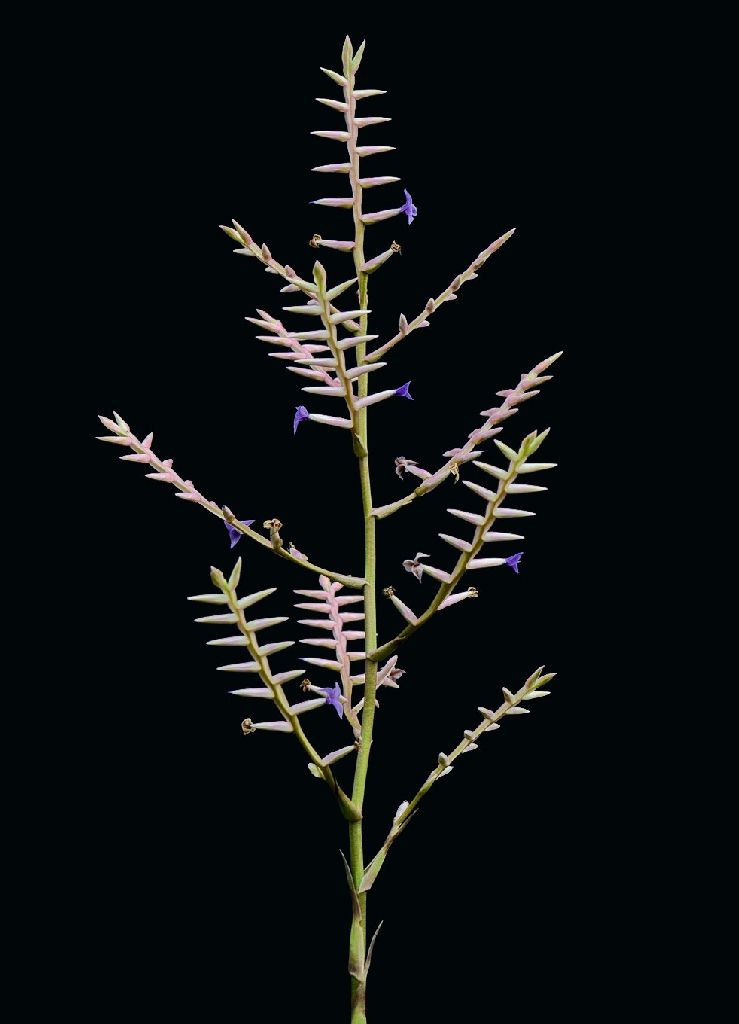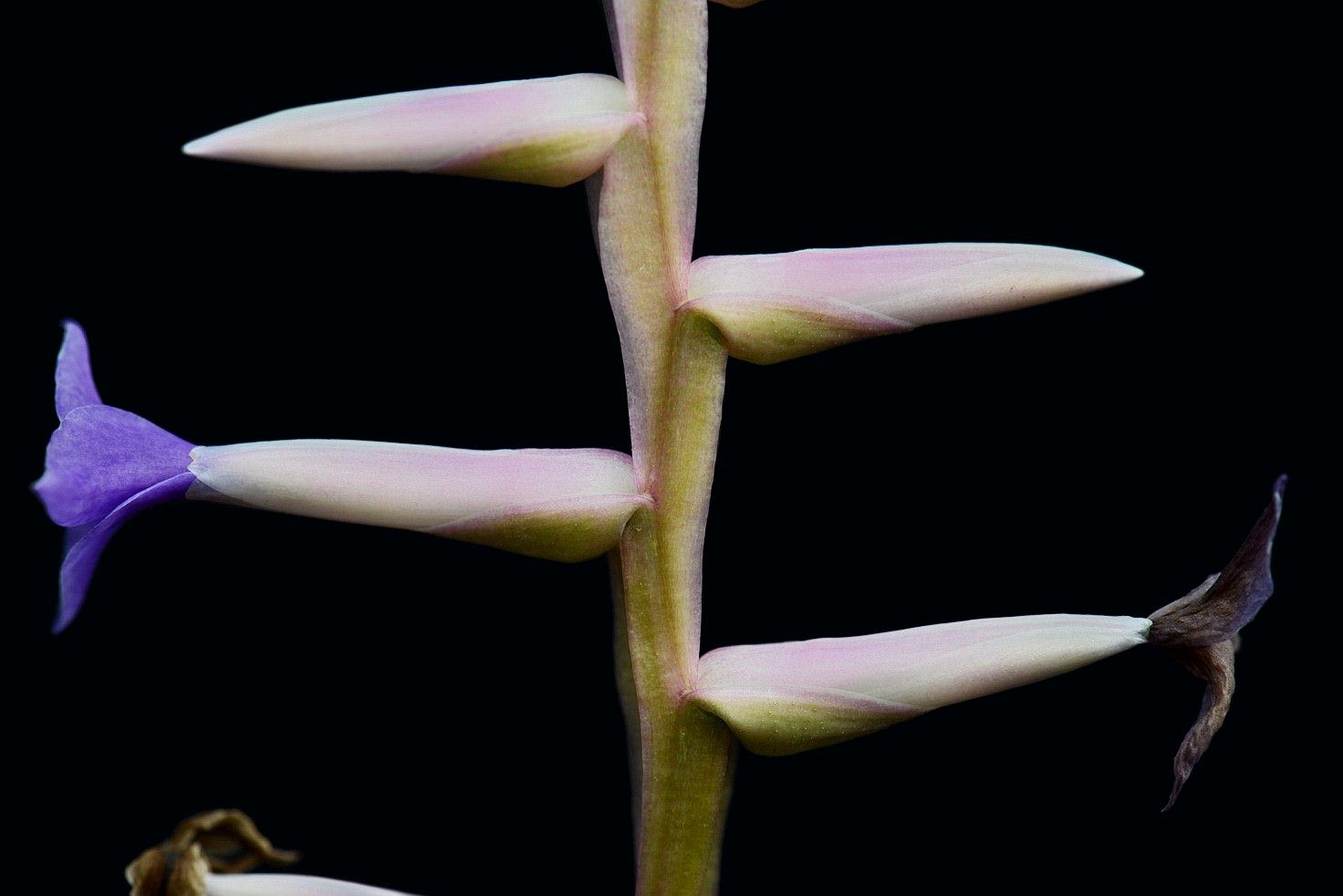Was Tillandsia laxissima
Now Barfussia laxissima (See DD02/17: for all new (DNA resolved) species & Cultivars.)
Click thumbnails for full size, scaled to a new window.
Barfussia laxissima


 Peter Tristram..."Not long ago my sole remaining pup of a form of T. laxissima, that Harry Luther gave me in 1988 at Selby, bloomed again.
Peter Tristram..."Not long ago my sole remaining pup of a form of T. laxissima, that Harry Luther gave me in 1988 at Selby, bloomed again.
It is a small grower compared to my other forms (probably var moorei and probably deserving of species status, but rarely blooms).
It is fragrant, like wagneriana and platyrhachis but also self-pollinates, unusual for plants in the prospective Rothowia genus (name pending).
Last time I bloomed this form I missed the seed which was kaput by the time I found out, but I am happy to share it later in the year. Another interesting plant in this group currently coming into bloom is a form of wagneriana that Jeff Kent collected in Ecuador as opposed to Peru."
Notes from Derek Butcher 2002:
Pamela Koide to Peter Tristram & Derek Butcher ... "Your first two pictures of T. laxissima, from Selby and from Hill, are the plants that were available here in the US for a couple of years that were grown from seed by Jeffrey Kent. He had called these the Bolivian form, and if I recall correctly, he acquired the seed orginally from Harry Luther. Which would explain why you saw one at Selby and at Herb's. The next two photos appear to be the same, the Peruvian form, v. moorei.
I acquired mine directly from Lee Moore some time ago. You are right, they are reluctant to pup, they make only one or two. I hope that helps."
Derek Butcher to Herb Plever ... "Herb: Many thanks for photos.
I am slowly getting the feeling that any Bromeliad grown from seed should be considered first in the Cultivar category rather than species. The number of instances I am getting of funny pollination in Tillandsia is quite astounding. I would suggest that the problem lies in the possible incorrect identification of 'Mother' in the first place which is further complicated by unknown fathers! In fact I am only using alleged quoted parents of a hybrid as just that these days when accepting a Cultivar Registration.
I am guessing that Pam's plants are seed raised and from seed not collected in the wild and to my mind should not be automatically accepted as having the same name as 'Mother'. Are Herb Hill's plants all from seed from a plant from Ecuador? Or do some come from the flowering of the plant/s we saw at the Orlando conference in 1996?
When trying to get a reference file of photos for the BCR for cultivars and fcbs.org for species I try to be as accurate as possible and this means I am always asking questions!
One thing I can say is that I am now getting an idea of what T. laxissima looks like! AND getting a photo from Selby of the var. moorei is a bonus."
Herb Plever to Derek Butcher ... "Dear Derek: The seedlings I am growing are from the Till. laxissima that flowered at the Orlando show. The seed was set while growing in my (closed) greenhouse. I am certain the seed will be a good representation of the potential genetic variations of the original plant. I believe this to be true, because seeds that I gave Reginald Deroose that flowered last year for him
were very homogeneous.
Seeds that are collected in the wild or in an open greenhouse are notorious for being contaminated by pollinators with foreign genetic material. I have seen this on numerous occasions from seed I collected in both Ecuador and Brazil. It is nearly impossible to obtain seeds of species grown by Brazilian growers that have not been contaminated. Their open shade houses are five star restaurants for hummingbirds and other pollinators. Also, as I am sure you know, habitat destruction increases the potential for species contamination. Good luck with your work."
Derek Butcher to Peter Tristram ... "The plot thickens. We now have Ecuador in the frame. Comments please."
Peter Tristram to Derek Butcher ... "Wally Berg gave me a plant he collected in Ecuador as Till. laxissima. It was quite nice when it bloomed at the World Bromeliad Conference in Orlando, Florida.
I saw that plant at Orlando and assumed it was a plant (seedling) from Selby as Harry's plant (see my photo) selfs and it looked like mine only grown in better light and pinker! Since it came from Wally, Selby could have been the source. I wonder what Pam has? My plant again: floral bracts 10mm; sepals 18-21mm, internodes 5mm, rachis completely exposed. It came from the road from Tarapoto to Moyabamba - maybe Rob Phillips remembers where so I'll try to contact him. It has one nice pup coming and set no seed at all, not even hybrids, whereas my other plant sets viable seed which are the hybrids I tried to do ie cyanea x."
Barfussia laxissima (Mez) Manzan. & W. Till, comb. nov. Phytotaxa 279(1): 001-097. 2016
Basionym:—Tillandsia laxissima Mez, Bull. Herb. Boissier ser. 2. 5(2): 108 (31 Jan 1905), Type:—Bang 2301 p.p. (holo B; iso G, GH, K!, LE!, M, MO, NY, PH!, US!, W!, WU!)
Tillandsia laxissima Mez, Bull. Herb. Boiss. II. 5: 108. 1905.
Desc from S&D p842-3
Leaves rather numerous in a dense rosette, 3 dm long;
Sheaths elliptic, large, covered with brown appressed scales;
Blades ligulate or slightly contracted at base, acute, 3 cm wide, chartaceous, green, minutely appressed-lepidote on both sides.
Scape unknown.
Inflorescence laxly and diffusely tripionate;
Axes slender, glabrous;
Primary bracts spreading, lance-ovate, shorter than the sterile bases of the branches;
Branches over 19 cm long;
Spikes linear, 9-13 cm long, 28 mm wide (without the fruit), very laxly 8-16-flowered.
Floral bracts spreading, elliptic, obtuse, 7 mm long, much shorter than the sepals, ecarinate, subcoriaceous, nerved, glabrous;
Flowers spreading, sessile.
Sepals subequally short-connate, subsymmetric, narrowly elliptic, obtuse, 13 mm long, ecarinate, coriaceous, nerved, glabrous;
Petals unknown. (Butcher - blue with spreading tips, stamens up to end of flower tube)
Capsule slenderly cylindric, abruptly acute, 35 mm long.
Type. Bang 2301 in part (holotype B, isotypes G, GH, M, MO, NY, US), without exact locality, Bolivia.
DISTRIBUTION. Known from the type collection only.
Barfussia laxissima var. moorei (H. Luther) Manzan. & W. Till, comb. nov. Phytotaxa 279(1); 001-097. 2016
Basionym:—Tillandsia laxissima var. moorei H. Luther, Selbyana 20(1): 13 (1999), Type:—Moore s.n. (holo SEL!)
Tillandsia laxissima Mez var moorei H. Luther, var. nov. Selbyana 20(1): 10-15. 1999
TYPE: Peru. San Martin: vic. Moyobamba. 1992. Lee Moore s n. (Holotype: SEL).
A T. laxissima Mez, cui affinis, foliis, bracteis florigeris et sepalis longiorbus differt.
This spectacular ornamental differs from the typical T. laxissima from the Departments of Santa Cruz and La Paz in Bolivia by having...
Leaves longer (85 cm vs. 30 cm)
Floral bracts longer (!0-12 mm vs. 6-7 mm)
Sepals longer (18-20 mm vs. 12-13 mm)
In all other details, as well as overall appearance, it is identical to the typical variety.
Note: Barfussia laxissima var. moorei (H.Luther) Manzon & W.Till has now been raised to species status => Barfussia moorei (H.Luther) E.Gouda
Updated 17/03/22


